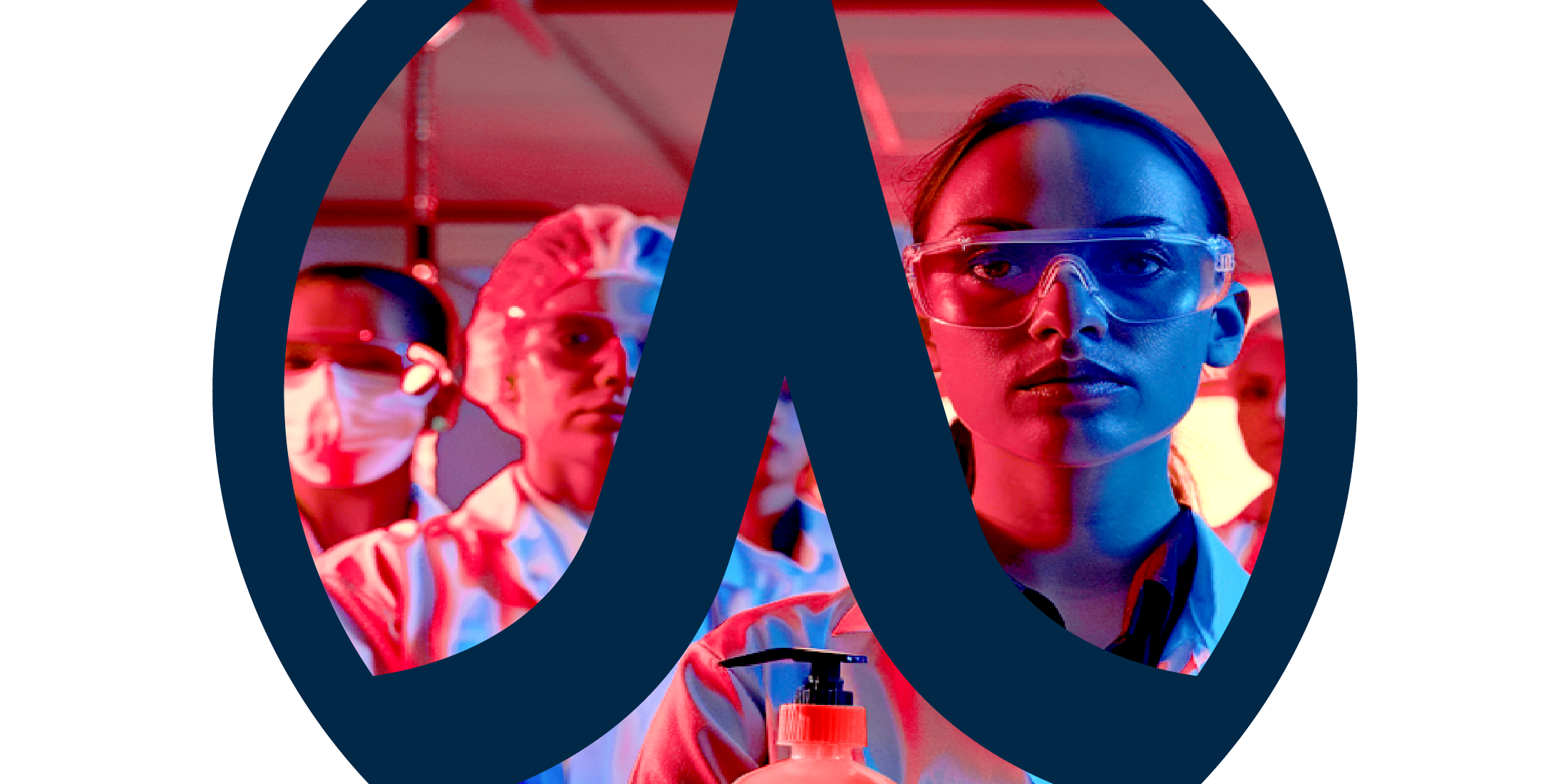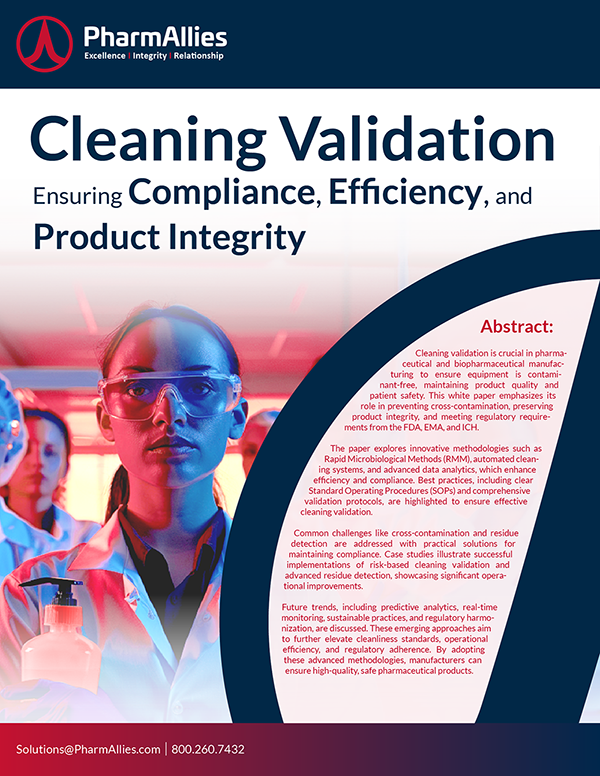Developing Effective Cleaning SOPs for Pharmaceutical Manufacturing
Introduction
Developing effective cleaning procedures is critical to ensuring the safety and quality of pharmaceutical and biopharmaceutical products and a critical step in the Cleaning Validation process. Standard Operating Procedures (SOPs) for cleaning are essential in preventing contamination, maintaining product integrity, and ensuring regulatory compliance. In this article, I’ll share the key factors involved in creating effective Cleaning SOPs, including residue solubility, equipment design, and product characteristics.
Understanding the Importance of Cleaning SOPs
As explained in our cleaning validation white paper, Cleaning SOPs are crucial for several reasons.
-
Preventing Cross-Contamination: Ensuring that residues from previous batches do not contaminate subsequent batches.
-
Patient Safety: Protecting patients from potential harm due to contamination.
-
Product Quality: Maintaining the integrity and efficacy of pharmaceutical products.
-
Regulatory Compliance: Meeting the strict guidelines set by regulatory bodies like the FDA, EMA, and ICH.
Key Factors in Developing Cleaning SOPs
Residue Solubility
Residue solubility is a critical factor in developing cleaning procedures. It determines the choice of cleaning agents and methods. Here’s how I have effectively addressed residue solubility in Cleaning SOPs throughout the years.
-
Identify Residues: Determine the types of residues that need to be cleaned. These can include active pharmaceutical ingredients (APIs), excipients, and by-products.
-
Solubility Testing: Conduct solubility testing for each type of residue to identify the most effective cleaning agents. Solubility testing involves experimenting with different solvents and surfactants to find the best solution for dissolving residues.
-
Choice of Cleaning Agents: Select cleaning agents based on their ability to dissolve the identified residues. Common cleaning agents include water, detergents, acids, and alkalis. Ensure that the chosen agents are compatible with the materials of the equipment and do not pose any risk to product quality. When selecting your cleaning agents, keep in mind that water is often used as a universal solvent due to its non-toxic nature. Choose your detergents based on their effectiveness in dissolving oils and grease, and select acids and alkalis based on their effectiveness in dissolving inorganic residues.
Equipment Design
The design of equipment is crucial for the effectiveness of cleaning procedures. When developing Cleaning SOPs, I consider the following aspects.
-
Accessibility: Ensure that all parts of the equipment are accessible for cleaning. This includes internal surfaces, pipes, and small crevices where residues can accumulate. The equipment should be easy to dismantle for thorough cleaning. Remember that rounded corners and smooth surfaces help prevent residue buildup.
-
Material Compatibility: Select cleaning agents that are compatible with the materials used in the equipment. Incompatible agents can cause corrosion or degradation, leading to equipment failure and potential contamination.
-
Ease of Disassembly: Design equipment for easy disassembly to facilitate thorough cleaning. Removable parts and modular designs can simplify the cleaning process.
-
CIP Systems: Incorporate Clean-In-Place (CIP) systems where feasible. CIP systems automate the cleaning process, ensuring consistency and reducing the risk of human error. Automated processes, ensure repeatability and reliability in cleaning. CIP systems should be validated to ensure they effectively clean all parts of the equipment.
Product Characteristics
When developing cleaning SOPs, it’s important to consider the unique characteristics of the products you’re manufacturing. These product-specific factors can significantly influence the cleaning process. Here’s my list of factors to consider
-
Physical Properties: Take into account the physical properties of the product, such as viscosity, solubility, and stickiness. Products with high viscosity or stickiness may require more robust cleaning procedures. As, high-viscosity products may leave thick residues that are harder to clean. Also, products that are less soluble may need stronger cleaning agents.
-
Chemical Stability: When choosing cleaning agents, consider the product’s chemical stability. Some products might react with specific cleaning agents, resulting in degradation or the creation of hazardous by-products. It’s important to ensure that cleaning agents do not react with any product residues. Furthermore, it’s advisable to avoid using cleaning agents that could cause the breakdown of the product.
-
Microbial Load: Assess the product’s microbial load to determine if microbial control measures are needed in the cleaning process. Products with high microbial loads may require the use of antimicrobial agents or sterilization procedures. Antimicrobial agents should be used when microbial contamination is a concern. Sterilization processes should be implemented where necessary to ensure complete microbial removal.
Steps in Developing Effective Cleaning SOPs
Developing effective cleaning SOPs involves several steps, from initial planning to validation. Here’s how I’ve broken it down step-by-step.
Step 1: Define Cleaning Requirements
Start by defining the cleaning requirements for your equipment and processes. Here’s how I’ve approached it.
-
Identifying Critical Cleaning Points: Determine the critical points in your equipment and processes where residues are likely to accumulate. Focus on areas prone to residue buildup. Pay special attention to surfaces that come into direct contact with products.
-
Setting Cleaning Objectives: Define the objectives of your cleaning procedures, such as removing specific types of residues, achieving a certain level of cleanliness, or preventing microbial contamination. Clarify what needs to be achieved through cleaning.
-
Establishing Acceptance Criteria: Set acceptance criteria for cleanliness, based on regulatory guidelines and product safety requirements. Acceptance criteria should include limits for residual APIs, cleaning agents, and microbial contamination. Ensure criteria meet or exceed regulatory requirements. Implement safety margins to account for variability in cleaning effectiveness.
Step 2: Select Cleaning Agents and Methods
Based on the residue solubility, equipment design, and product characteristics, select appropriate cleaning agents and methods:
-
Cleaning Agents: Choose agents that effectively dissolve or remove residues without damaging equipment or affecting product quality. Consider factors such as concentration, temperature, and contact time. Ensure cleaning agents do not interact negatively with residues or equipment. Select agents that clean effectively within acceptable time frames.
-
Cleaning Methods: Select methods suitable for your equipment and processes. Common methods include manual cleaning, automated cleaning, and CIP systems. Each method has advantages and limitations, so choose the one that best fits your needs.
Step 3: Develop Detailed SOPs
Develop detailed SOPs that outline the cleaning procedures step-by-step. I’ve made sure that these SOPs are clear, concise, and easy to follow. Here are the elements I’ve included.
-
Preparation: Describe the preparation steps, such as removing product residues, disassembling equipment, and gathering cleaning materials. For example, ensure equipment is free of large debris before cleaning.
-
Cleaning Process: Provide detailed instructions for the cleaning process, including the cleaning agents used, their concentration, and the method of application. Specify the cleaning time, temperature, and any mechanical actions required. Outline each step clearly to avoid confusion.
-
Rinsing and Drying: Include steps for rinsing and drying the equipment. Ensure that all cleaning agents are thoroughly removed to prevent contamination. No residue of cleaning agents should remain. Also, ensure that equipment is properly dried to prevent microbial growth.
-
Inspection and Verification: Describe the inspection and verification steps to ensure that the equipment is clean. This can include visual inspections, swab tests, and analytical testing for residues. Visual Inspections – Look for visible residues. Swab Tests – Test for residues on surfaces. Analytical Testing – Use chemical analysis to detect residuals.
Step 4: Train Personnel
Ensure that all personnel involved in the cleaning process are adequately trained. Here’s what I’ve included in the training.
-
Understanding SOPs: Ensure that personnel understand the SOPs and can follow them accurately. Conduct regular training sessions and refreshers.
-
Handling Cleaning Agents: Train personnel on the safe handling and use of cleaning agents. Emphasize safety measures and personal protective equipment (PPE).
-
Performing Inspections: Train personnel to perform inspections and verify the cleanliness of equipment. Use both visual and instrumental inspection methods.
-
Troubleshooting: Provide training on troubleshooting common issues that may arise during the cleaning process. Equip staff with the skills to identify and solve cleaning issues quickly.
Step 5: Validate Cleaning Procedures
Validation is a critical step in developing effective cleaning procedures. In my experience, it provides documented evidence that the cleaning procedures are effective and reproducible. Here’s what validation involves.
-
Developing a Validation Plan: Create a validation plan that outlines the validation activities, acceptance criteria, and documentation requirements. The validation plan includes detailed protocols for validation activities.
-
Conducting Validation Studies: Perform validation studies to demonstrate that the cleaning procedures are effective. This typically involves multiple cleaning cycles and includes worst-case scenarios. Test under various conditions to ensure reliability.
-
Analyzing Results: Analyze the validation studies’ results to ensure that the acceptance criteria are met. Identify any deviations and implement corrective actions if necessary. Use statistical methods to analyze results.
-
Documenting Validation: Thoroughly document the validation activities, including the validation plan, study results, and any corrective actions taken. Keep detailed and organized records for regulatory inspections.
Step 6: Implement Continuous Monitoring and Improvement
After validating the cleaning procedures, implement a system for continuous monitoring and improvement. This ensures that the cleaning procedures remain effective over time. Continuous monitoring involves.
-
Regular Inspections: Conduct regular inspections to verify the cleanliness of equipment. Use visual inspections, swab tests, and analytical testing as appropriate. Schedule regular inspections to maintain standards.
-
Trend Analysis: Analyze trends in cleaning performance to identify any potential issues. Monitor parameters such as residue levels, cleaning times, and equipment performance. Track key indicators of cleaning effectiveness.
-
Periodic Revalidation: Perform periodic revalidation of the cleaning procedures to ensure their continued effectiveness. Revalidation should be conducted whenever there are changes to the equipment, cleaning agents, or processes. Revalidate based on changes in process or equipment.
-
Implementing Improvements: Use the data from continuous monitoring to identify areas for improvement. Implement corrective and preventive actions (CAPA) to enhance the effectiveness of the cleaning procedures. Create a process for incorporating feedback into SOP updates.
Conclusion
In my experience, developing effective cleaning procedures is essential for ensuring the safety and quality of pharmaceutical and biopharmaceutical products. By considering factors such as residue solubility, equipment design, and product characteristics, manufacturers can create robust SOPs that prevent contamination, maintain product integrity, and comply with regulatory requirements.
To recap, I start by defining cleaning requirements, selecting appropriate cleaning agents and methods, developing detailed SOPs, training personnel, validating cleaning procedures, and implementing continuous monitoring and improvement.
By investing in thorough and effective cleaning procedures, we can safeguard our products and protect patient health. This systematic approach has helped our client achieve their goals and ensure that their products remain safe and effective.



